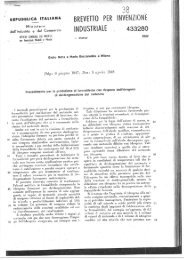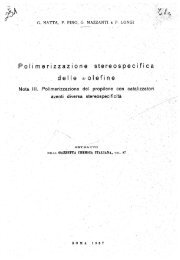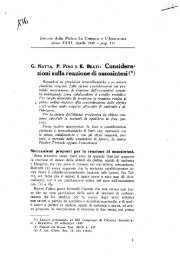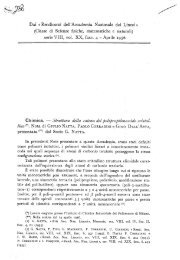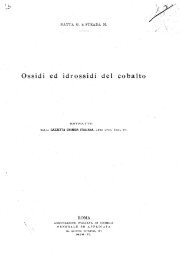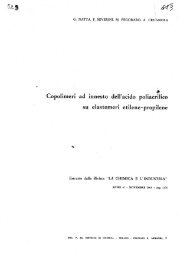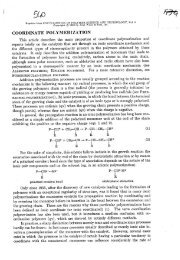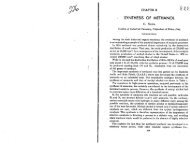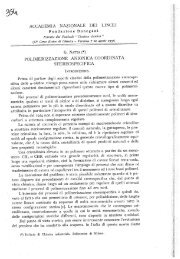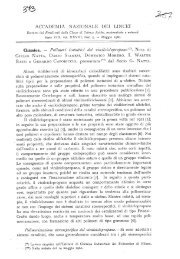n. 7, Ottobre 2003 - Giulio Natta
n. 7, Ottobre 2003 - Giulio Natta
n. 7, Ottobre 2003 - Giulio Natta
Create successful ePaper yourself
Turn your PDF publications into a flip-book with our unique Google optimized e-Paper software.
Prolusione del Professor <strong>Giulio</strong> <strong>Natta</strong><br />
Inaugural lecture by Professor <strong>Giulio</strong> <strong>Natta</strong><br />
monomeriche presentano di per sé<br />
una elevata simmetria, oppure una<br />
particolare struttura polifunzionale,<br />
si ottenevano generalmente, per<br />
polimerizzazione, dei prodotti a<br />
struttura disordinata che era la<br />
causa delle deficienti caratteristiche<br />
termiche e meccaniche e li rendeva<br />
di limitato interesse pratico.<br />
Il chimico, sino a pochi anni fa, non<br />
era capace di ottenere da tali elementi<br />
costruttivi che delle macromolecole<br />
bidimensionali o tridimensionali,<br />
a struttura irregolare,<br />
o tutt'al più sapeva dare alla costruzione<br />
una forma prevalentemente<br />
lineare ma irregolare e ramificata.<br />
Molecole giganti a strutture corrispondenti<br />
a modelli ben precisi ci<br />
vengono invece largamente fornite<br />
dalla natura nelle molecole aventi<br />
funzioni fondamentali negli organismi<br />
viventi.<br />
L'uomo senza saperlo ha utilizzato,<br />
già dalla preistoria, delle macromolecole<br />
come alimento, come vestiario,<br />
come materiale da costruzione.<br />
Esse furono però le ultime ad essere<br />
ben conosciute dal chimico. Solo<br />
in questi ultimi decenni si è cominciato<br />
a conoscerne la intima natura<br />
e soprattutto l'architettura interna.<br />
La prima sostanza organica a basso<br />
peso molecolare ottenuta per sintesi<br />
fu preparata da Wohler 130 anni<br />
fa (1828). Per oltre un secolo<br />
migliaia di chimici hanno demolito<br />
e sintetizzato molecole organiche,<br />
hanno creato centinaia di migliaia<br />
di sostanze organiche diverse, per<br />
lo più a basso peso molecolare,<br />
sostanze che il chimico per estrazione,<br />
cristallizzazione, distillazione, si<br />
sforzava di ottenere purissime. La<br />
teoria della quadrivalenza del carbonio<br />
ne spiegava la natura e<br />
lasciava prevedere la sintesi, il chimico<br />
le utilizzò per ottenere<br />
migliaia di prodotti sintetici più o<br />
meno semplici, alcuni di interesse<br />
pratico: coloranti, solventi, profumi,<br />
medicamenti.<br />
Passando dalle molecole relativamente<br />
piccole alle molecole giganti<br />
naturali, il chimico si trovava di<br />
fronte ad un problema troppo complicato.<br />
Tali molecole non si lasciavano<br />
trattare con i metodi classici<br />
della chimica organica, non fondevano,<br />
non cristallizzavano, non si<br />
discioglievano indecomposte. Il chimico<br />
non sapeva quindi da che<br />
parte aggredirle per individuarne la<br />
intima struttura molecolare e le<br />
caratteristiche. I mezzi di cui il chimico<br />
disponeva erano troppo grossolani<br />
por poter isolare ad uno ad<br />
uno gli elementi costruttivi le cui<br />
dimensioni sono, come ordine di<br />
grandezza, molto più piccole, del<br />
limite di visibilità microscopica, e<br />
per disporli con un ordine prestabilito.<br />
Si pensi che una sola goccia di<br />
un monomero contiene un ordine<br />
di grandezza di 10 20 molecole semplici.<br />
Alcune macromolecole, come la<br />
cellulosa, potevano venire modificate<br />
nelle loro proprietà con trattamenti<br />
chimici, e ciò diede vita a<br />
rami importanti della chimica, quali<br />
ad es. ad una classe importante di<br />
esplosivi e di materie plastiche,<br />
all'industria delle fibre tessili artificiali,<br />
ai rayon alla viscosa e all'acetato<br />
di cellulosa.<br />
Si sapeva anche che alcune molecole<br />
giganti naturali erano costituite<br />
da un concatenamento regolare di<br />
elementi costitutivi relativamente<br />
semplici, per lo più uguali tra loro<br />
(glucosio nel caso della cellulosa;<br />
amminoacidi nel caso della lana,<br />
della seta e di altre sostanze proteiche;<br />
isoprene nel caso della gomma<br />
naturale) ma l'uomo era incapace di<br />
riprodurle.<br />
Questo il grado di conoscenza cui<br />
era pervenuto il chimico nel campo<br />
della sintesi delle macromolecole<br />
fino a quattro anni or sono.<br />
La scoperta realizzata nell'Istituto di<br />
Chimica Industriale di questo<br />
Politecnico nei primi mesi del 1954,<br />
che ha profondamente rivoluzionato<br />
la chimica macromolecolare,<br />
schiudendo enormi possibilità di<br />
realizzazioni pratiche, consiste concettualmente,<br />
in questo: è, stato trovato<br />
un processo per il quale, partendo<br />
da composti chimici semplici<br />
non saturi, operando in presenza di<br />
particolari catalizzatori, si possono<br />
ottenere grandi molecole caratterizzate<br />
da strutture spaziali ordinate e<br />
prestabilite. Abbiamo denominato<br />
stereospecifici i catalizzatori e polimerizzazione<br />
stereospecifica il processo<br />
che consente di ottenere le<br />
grandi molecole a struttura ordinata<br />
e prestabilita.<br />
Da questo momento il chimico, è<br />
stato messo in grado di costruire<br />
delle macromolecole secondo schemi<br />
architettonici preordinati con le<br />
proprietà desiderate.<br />
I primi elementi costruttivi da noi<br />
usati sono stati i più semplici idrocarburi<br />
non saturi.<br />
È stato trovato che certi cristalli a<br />
strati di ioni aventi una particolare<br />
struttura reticolare, assorbono composti<br />
metallorganici, formando in<br />
superficie dei complessi catalitici<br />
asimmetrici aventi una particolare<br />
struttura ed un particolare tipo di<br />
coordinazione, con legami cosidetti<br />
a ponte, elettrone-deficienti.<br />
Tali complessi agiscono da catalizzatori<br />
in un particolare e nuovo tipo<br />
di polimerizzazione, quella anionica<br />
coordinata, per cui le unità monomeriche<br />
reagiscono soltanto se si<br />
dispongono orientate in un modo<br />
particolare, tale da differenziare<br />
moleocole eguali ma enantiomorfe<br />
(l'una immagine speculare ma non<br />
sovrapponibile dell'altra). In tal<br />
modo si sono ottenute strutture<br />
nuove e diverse a seconda del tipo<br />
e dell'ordine di tale concatenamento.<br />
Unità monomeriche, molto asimmetriche,<br />
possono collegarsi in<br />
strutture simmetriche che assumono<br />
spesso una forma di eliche.<br />
Le molecole giganti così ottenute,<br />
costituite da centinaia di migliaia di<br />
piccole molecole che si sono fuse in<br />
una più grande, posseggono proprietà<br />
eccezionali dipendenti dalla<br />
loro architettura interna e dal grado<br />
di ordine che può venire modificato<br />
a piacere entro larghi limiti.<br />
Da idrocarburi semplici, ad esempio<br />
dalle olefine che costituiscono i<br />
componenti principali del gas di<br />
cracking del petrolio, (una volta inutilizzabili<br />
se non come combustibile<br />
povero) si possono così ottenere a<br />
piacere delle macromolecole lineari,<br />
lunghe da 1.000 a 100.000 volte il<br />
loro diametro, aventi una forma di<br />
elica a simmetria ternaria ed a<br />
passo regolare, che possono cristallizzare<br />
e fornire fibre aventi la resistenza<br />
del nylon.<br />
La struttura cristallina determina<br />
units show a high degree of<br />
symmetry per se, or a particular<br />
multifunctional structure, products<br />
with a disordered structure were<br />
generally obtained by means of<br />
polymerisation, which was the<br />
cause of their poor thermal and<br />
mechanical properties and made<br />
them of limited practical interest.<br />
Up to a few years ago, the chemist<br />
could only obtain bi-dimensional or<br />
three-dimensional macromolecules<br />
from such building elements, with<br />
irregular structures, or at the most<br />
could give the construction a<br />
mainly linear form, yet irregular<br />
and branched.<br />
Giant molecules with structures<br />
corresponding to well defined<br />
models are instead largely provided<br />
by nature in molecules having<br />
fundamental functions in living<br />
beings.<br />
Without knowing it, Man was<br />
already using macromolecules as<br />
food, clothing, building materials in<br />
prehistory. And yet, to the chemist,<br />
macromolecules were the last to<br />
become well known. Only in the<br />
last decades have we begun to<br />
know their intimate nature and,<br />
particularly, their inner architecture.<br />
The first organic substance with<br />
low molecular weight obtained by<br />
means of synthesis was prepared<br />
by Wohler 130 years ago (1828).<br />
For over a century, thousands of<br />
chemists have demolished and<br />
synthesised organic molecules,<br />
have created hundreds of thousands<br />
of different organic substances,<br />
for the most with low molecular<br />
weight, substances that the chemist,<br />
by means of extraction,<br />
crystallisation, distillations, tried to<br />
obtain as pure as possible. The<br />
theory of tetravalence of carbon<br />
explained its nature and made its<br />
synthesis foreseeable, and the chemist<br />
used it to obtain thousands of<br />
more or less simple synthetic products,<br />
some of them with practical<br />
interest: dyes, solvents, perfumes,<br />
drugs.<br />
Going from relatively small to giant<br />
natural molecules, the chemist was<br />
faced with a too complicated problem.<br />
These molecules could not<br />
be treated by means of the classical<br />
methods of organic chemistry,<br />
they did not melt, they did not<br />
crystallise, they did not dissolve<br />
without decomposing. The chemist<br />
therefore did not know from which<br />
side to tackle them to find their intimate<br />
molecular structure and features.<br />
The means available to the<br />
chemist were too crude to isolate<br />
every single building element,<br />
whose sizes are, in terms of magnitude,<br />
much smaller than the limit<br />
of microscopic visibility, and to<br />
arrange them according to a set<br />
order. It only need be considered<br />
that one single drop of a monomer<br />
contains a magnitude of 1020 simple<br />
molecules.<br />
Some macromolecules, such as<br />
cellulose, could be modified in<br />
their properties by means of chemical<br />
treatments, and this gave life<br />
to significant branches of chemistry,<br />
such as for example a significant<br />
class of explosives and plastics,<br />
to the industry of man-made<br />
textile fibres, rayon, viscose and<br />
cellulose acetate.<br />
It was known that some natural<br />
giant molecules were made of a<br />
regular linking of relatively simple<br />
building elements, largely equal<br />
among themselves (glucose in the<br />
case of cellulose; amino acids in<br />
the case of wool, silk and other<br />
protein substances; isoprene in the<br />
case of natural rubber) but man<br />
was not able to reproduce them.<br />
This was the degree of knowledge<br />
of the chemist in the field of the<br />
synthesis of macromolecules until<br />
four years ago.<br />
The discovery made in the Institute<br />
of Industrial Chemistry of the<br />
Politecnico in early 1954, which<br />
deeply revolutionized macromolecular<br />
chemistry, opening enormous<br />
opportunities of practical achievements,<br />
is conceptually the following:<br />
a process has been devised<br />
by means of which, starting from<br />
simple non saturated chemical<br />
compounds, working in the presence<br />
of specific catalysts, large molecules<br />
can be obtained characterised<br />
by ordered and predefined<br />
space structures. We called the<br />
catalysts stereospecific, and stereospecific<br />
polymerisation the process<br />
which makes it possible to obtain<br />
large molecules with an ordered<br />
and predefined structure.<br />
From this moment the chemist has<br />
been enabled to build macromolecules<br />
according to pre-established<br />
architectural patterns and with the<br />
desired properties.<br />
The first building elements we<br />
have used have been the simplest<br />
non saturated hydrocarbons.<br />
It has been found that some<br />
crystals with ion layers having a<br />
specific reticular structure, absorb<br />
metallorganic compounds and<br />
form on the surface asymmetrical<br />
catalyst complexes, having a specific<br />
structure and a particular type<br />
of coordination, with so called bridge<br />
bonds, electron-deficient.<br />
Such complexes act as catalysts in<br />
a particular and new type of polymerisation,<br />
coordinated anionic<br />
polymerisation, for which monomer<br />
units only react when they are<br />
oriented in a particular way, such<br />
as to differentiate equal but enantiomorphous<br />
molecules (one is the<br />
specular but not overlapping image<br />
of the other). In this way, new and<br />
different structures have been<br />
obtained, according to the type and<br />
order of such linking.<br />
Monomer, highly asymmetrical<br />
units, can connect in symmetrical<br />
structures which often take the<br />
shape of spirals. Giant molecules<br />
obtained his way, made up of hundreds<br />
of thousands of small molecules<br />
that have combined into a<br />
larger one, possess exceptional<br />
properties depending on their inner<br />
architecture and the degree of<br />
order which can be changed as<br />
required within large limits.<br />
From simple hydrocarbons, e.g.<br />
from olefins which are the main<br />
components of oil cracking gas,<br />
(once impossible to use unless as<br />
lean fuel) linear molecules can thus<br />
be obtained of length from 1,000 to<br />
100,000 times their diameter,<br />
having the shape of spiral with ternary<br />
symmetry and regular pitch,<br />
which can crystallise and produce<br />
fibres, having the strength of<br />
nylon.<br />
Crystalline structure determines a<br />
certain analogy between the beha-<br />
74<br />
75



